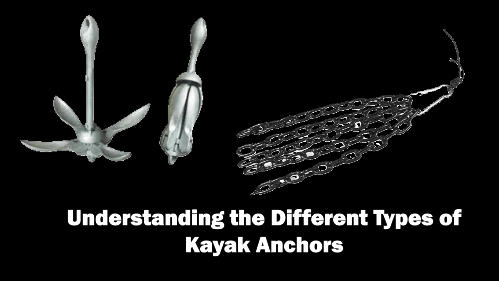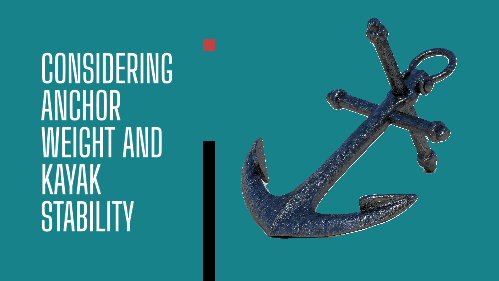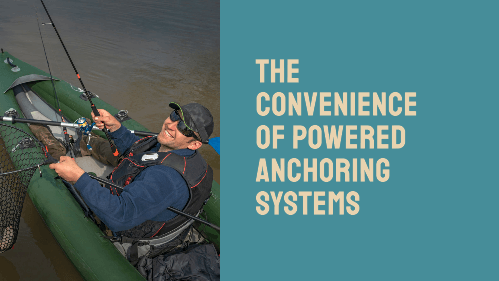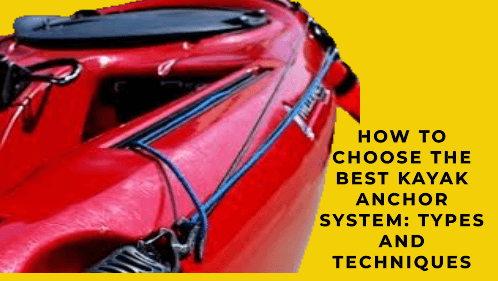When deciding on Kayak Anchor System you should buy, there are few things you need to keep in mind, especially when you’ve found the perfect fishing spot or you’re ready to soak in the beauty of your surroundings.
The Importance of a Kayak Anchor System

That’s where a kayak anchor system comes into play. Not only does it offer stability, allowing you to remain stationary, but it also enhances your safety by preventing unwanted drifts into dangerous areas.
Understanding the Different Types of Kayak Anchors

Anchor systems for kayaks come in a variety of shapes and sizes, each designed for a specific environment and type of bottom—whether it’s sandy, rocky, or muddy.
The most common types of anchors include:
- The versatile grapnel anchor, which is foldable with sharp prongs ideal for gripping a variety of seabed conditions;
- The simple stakeout pole that’s best for shallow waters; the weighty drag chain, which is perfect for rocky riverbeds;
- The top-tier powered anchoring systems that provide easy and quick anchoring in various situations.
Choosing the Right Anchor for Your Situation

It’s not just about picking any anchor, though. Different scenarios demand different types of anchors.
- A folding grapnel anchor might be your go-to for its compact design and multipurpose use
- A stakeout pole could be the better choice for quietly stabilizing your position in knee-deep waters.
- A drag chains are an excellent option if you’re navigating rocky terrains, as they help to slow down the kayak’s drift without getting easily snagged.
Making the Right Choice: Factors to Consider
So how do you determine which kayak anchor system is best for you? You’re going to find out about that in the next section, where I’ll guide you through the considerations needed to make the right choice.
This includes:
1. Assessing the bottom type you’ll be anchoring in
2. The weight of the anchor compared to your kayak
3. The convenience features that could make your kayaking experience much more enjoyable.
After all, it’s all about getting you equipped so you can focus on what you set out to do—whether it’s catching the big one or capturing the serenity of the water.
Selecting the Ideal Anchor for Your Needs

When it comes to choosing the right anchor for your kayak or SUP, your primary focus should be the environment you’ll journey into.
The wrong anchor in the wrong place can be as good as no anchor at all or, worse, a safety risk.
Here’s what you need to consider:
1. Understanding Bottom Types and Anchor Suitability

The bottom type of the body of water where you will be kayaking is essential. A grapnel anchor, with its foldable sharp prongs, is quite versatile, great for sandy or weedy bottoms, as well as for soft mud. It digs in and holds tight, but in rocky areas, it might get stuck, so be cautious.
2. Considering Anchor Weight and Kayak Stability

Your kayak’s stability and your comfort are directly impacted by the weight of your anchor. That’s where the balance comes in.
An anchor too light might not hold your kayak steady, while one that’s too bulky could compromise the stability of your kayak or be difficult to haul in.
A general rule of thumb is 1.5 pounds per every 1 foot of kayak length, but always adjust for conditions like wind or current.
3. The Convenience of Powered Anchoring Systems

For practical reasons, you might lean towards a powered anchoring system. Especially if you’re into sight fishing, the speed and convenience they offer can’t be beaten.
With the push of a button, you can hold your position and focus entirely on your fishing without wrestling with ropes and manual anchors.
4. Making an Informed Choice: Accessories and Techniques
After careful consideration of these factors, you’ll be well on your way to making an informed choice.
But the decision-making doesn’t stop there. Next, we’re going to delve into the accessories that can make anchoring a breeze and the techniques that’ll keep you safe while you’re enjoying the waterways.
Essential Accessories and Techniques for Kayak Anchoring
I’m here to help you navigate the sometimes overlooked, but absolutely crucial, components of kayak anchoring: accessories and techniques.
Don’t worry too much about getting overwhelmed; I’ve got your back on this. You’re going to find out just how to make anchoring a breeze with the right gear and know-how.
The Anchor Trolley: Your Adjustable Anchoring Solution
First up, let’s talk about the anchor trolley. This nifty device is your ticket to adjustable anchoring, letting you run your anchor line from the bow to the stern with ease.
It allows for better kayak positioning against wind and current, making sure you stay put where you want to. Choose something that resonates with you in terms of ease of installation and durability.
Rope Size and Its Impact on Anchoring

Next, rope size matters way more than you might think. My go-to recommendation is a 3/16-inch polyester clothesline.
It strikes a balance between strength and manageability, so you’re not wrestling with your setup when you should be fishing or soaking in the surroundings.
Adding Stability with Chains in Deeper Waters

If you’re venturing into deeper waters with stronger currents, consider a chain. A 3/8-inch chain for heavy kayaks provides the added weight and stability you’ll need in swifter or deeper conditions. It serves as a helpful deterrent against drifting, which can be both an annoyance and a safety hazard.
Anchor Line Length: Ensuring a Secure Hold

Now, anchor line length is a whole topic in itself. As a rule of thumb, aim for a line that’s twice as long as the water’s depth.
This ensures a proper anchoring angle and, ultimately, a secure hold. Adjust your approach depending on local conditions – you can always let out more line, but coming up short could force an unintentional change of spot.
Navigating Your Anchor Choice: Harnessing the Serenity of the Waters

In my opinion, choosing the right kayak anchor is akin to selecting a trusted companion for your aquatic adventures.
It’s about finding the ally that helps you stay put, so you can relish the tranquility or focus on the catch of the day.
I’ve laid out the detailed considerations for picking anchors suited for various conditions and environments, but don’t worry too much about getting it perfect on the first try. You can always adjust your approach down the road.
Securing Your Kayak and Experience: Matching the Anchor to Your Destination
When you opt for an anchoring system that mirrors the demands of your destination—be it a serene lake, a flowing river, or the vast ocean—you’re not just securing your kayak; you’re also safeguarding your experience.
Choose something that resonates with you, and that meets the technical requirements of your outings.
And remember, your anchor kit is more than just a tool. It’s a critical part of your journey that allows for hands-free enjoyment whether you’re observing nature, practicing yoga, or engaging in lively conversations with friends.
Reflecting on Your Kayaking Lifestyle: Finding the Perfect Anchor Fit

So my question to you today is, have you found the anchor that best suits your kayaking lifestyle? If you’re still in doubt, consider the insights shared and align them with your personal preferences and the specific nature of your usual kayaking spots.
Always be prepared to ask yourself, ‘Does this anchor system meet the challenges I’ll face on the water?’
Navigating Anchor Choices: Confidence on the Water
I really hope that you feel more confident in navigating through your options now. With the right anchor and the techniques to use it effectively, you’re ready to harness the full potential of peace and pleasure that every body of water has to offer.
Remember that your first attempt doesn’t need to be your last—you’re on an evolving journey that adapts and grows with each new wave.
